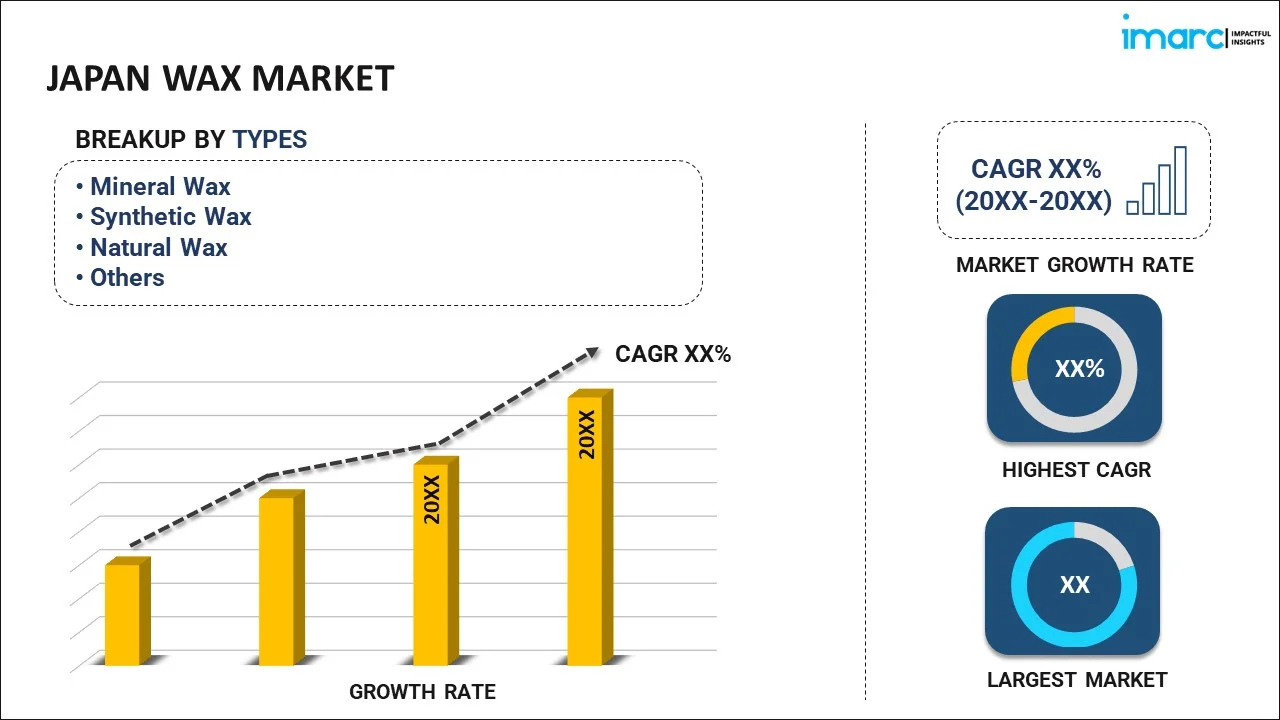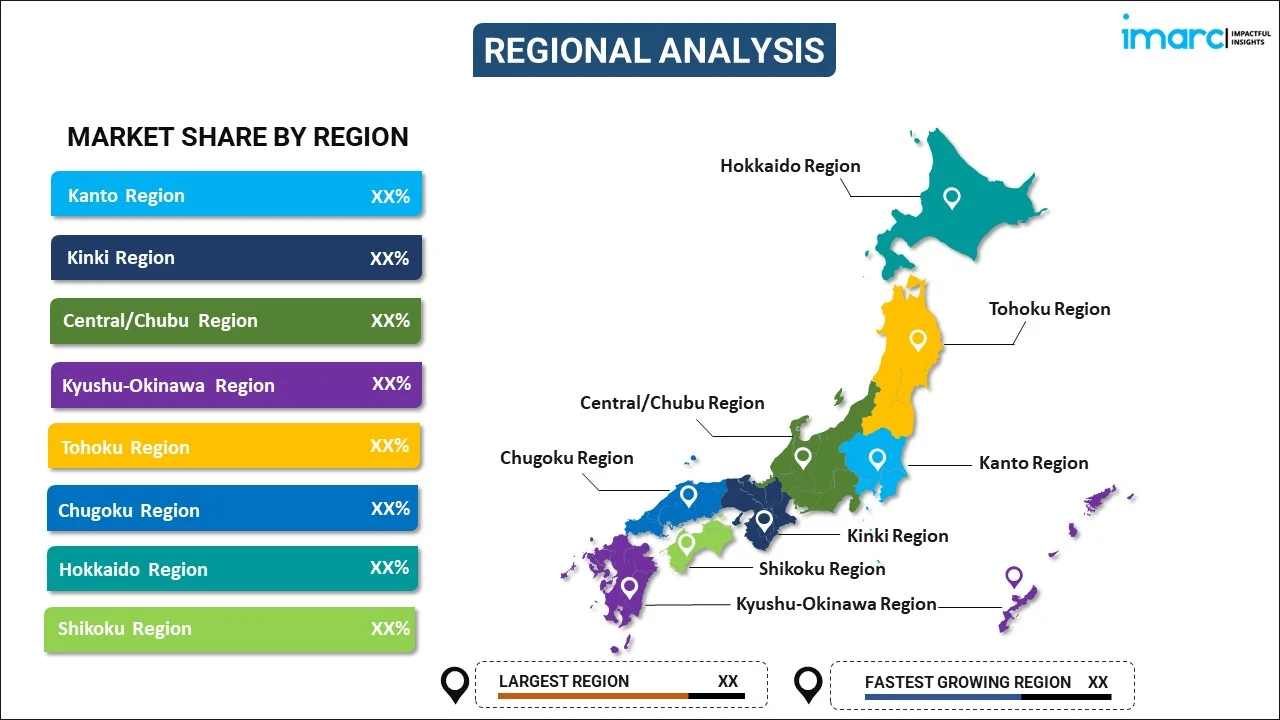
Japan Wax Market Report by Type (Mineral Wax, Synthetic Wax, Natural Wax, and Others), Form (Flakes, Granules, Powder, and Others), Application (Candles, Cosmetics, Packaging, Emulsions, Hot Melts, Floor Polishes, and Others), and Region 2025-2033
Market Overview:
The Japan wax market size reached USD 643.0 Million in 2024. Looking forward, IMARC Group expects the market to reach USD 892.0 Million by 2033, exhibiting a growth rate (CAGR) of 3.6% during 2025-2033. The expanding industrial sector, increasing product adoption in cosmetics and personal care, growing significance of candle manufacturing, rising utilization of wax in food packaging, stringent environmental regulations, and extensive research and development activities represent some of the key factors driving the market.
|
Report Attribute
|
Key Statistics
|
|---|---|
|
Base Year
|
2024 |
|
Forecast Years
|
2025-2033
|
|
Historical Years
|
2019-2024
|
| Market Size in 2024 | USD 643.0 Million |
| Market Forecast in 2033 | USD 892.0 Million |
| Market Growth Rate (2025-2033) | 3.6% |
Wax is a versatile organic substance that exists in various forms and finds applications in diverse industries. It is composed of long-chain hydrocarbons, primarily from plant and animal sources, and possesses a solid yet pliable texture at room temperature. One of the most common types is beeswax, produced by honey bees, which has been used historically for various purposes. Additionally, paraffin wax, derived from petroleum refining, is widely employed in cosmetics, candle making, and food packaging industries. The properties of wax, such as its low reactivity with other substances and resistance to degradation, make it a popular choice for different applications. In the cosmetic industry, it is utilized in creams, lotions, and lip balms due to its emollient and protective qualities. The candle-making industry benefits from the wax's combustible nature, providing a steady and controllable flame. Moreover, wax is used in the food industry as a coating for fruits and cheeses, enhancing their shelf life. Beyond these applications, wax serves various roles in art, pharmaceuticals, and even as a protective coating for certain surfaces. Its versatility, stability, and natural origins contribute to its widespread usage across different sectors. As market research and consulting professionals, understanding the extensive applications and unique characteristics of wax can add value to client interactions and foster thought leadership in relevant domains.
Japan Wax Market Trends:
The expanding industrial sector plays a crucial role in driving the demand for wax in Japan. The country's manufacturing industries, including automotive, electronics, and packaging, utilize wax in various processes. For instance, in the automotive sector, wax is used for mold release agents and surface coatings, while the electronics industry relies on it for encapsulating and protecting sensitive components. Additionally, wax is a vital ingredient utilized in the formulation of skincare products, haircare items, and cosmetics. Its emollient properties and ability to enhance product texture and stability, make it a sought-after ingredient in used in creams, lotions, and lip balms. Other than this, candles hold cultural significance in Japan and are used in various religious and traditional ceremonies. Scented candles have gained popularity as a lifestyle product. As a result, the demand for wax as the primary raw material in candle manufacturing remains steady. Besides this, the food industry in Japan extensively uses wax in food packaging applications. Wax coatings on fruits and vegetables help extend their shelf life and preserve freshness. Moreover, wax-coated paper is utilized in packaging for confectionery items and certain food products. In line with this, the pharmaceutical industry in Japan relies on wax for various applications, including the production of capsules and as a coating for certain medications. Medical devices, such as catheters and surgical instruments, may also incorporate wax-based coatings for improved performance. Furthermore, Japan’s commitment to environmental sustainability and eco-friendly practices influences the market. Besides this, there is a shift toward using bio-based and renewable wax sources to meet environmental goals. Moreover, ongoing research and development efforts in the wax industry drive innovation and the introduction of advanced wax products. This includes the development of specialized waxes with improved properties tailored to specific applications, thus expanding the market potential.
Japan Wax Market Segmentation:
IMARC Group provides an analysis of the key trends in each segment of the Japan wax market report, along with forecasts at the country level for 2025-2033. Our report has categorized the market based on type, form, and application.
Type Insights:

- Mineral Wax
- Synthetic Wax
- Natural Wax
- Others
The report has provided a detailed breakup and analysis of the market based on the type. This includes mineral wax, synthetic wax, natural wax, and others.
Form Insights:
- Flakes
- Granules
- Powder
- Others
A detailed breakup and analysis of the market based on the form has also been provided in the report. This includes flakes, granules, powder, and others.
Application Insights:
- Candles
- Cosmetics
- Packaging
- Emulsions
- Hot Melts
- Floor Polishes
- Others
The report has provided a detailed breakup and analysis of the market based on the application. This includes candles, cosmetics, packaging, emulsions, hot melts, floor polishes, and others.
Regional Insights:

- Kanto Region
- Kinki Region
- Central/Chubu Region
- Kyushu-Okinawa Region
- Tohoku Region
- Chugoku Region
- Hokkaido Region
- Shikoku Region
The report has also provided a comprehensive analysis of all the major regional markets, which include Kanto region, Kinki region, Central/ Chubu region, Kyushu-Okinawa region, Tohoku region, Chugoku region, Hokkaido region, Shikoku region.
Competitive Landscape:
The report has also provided a comprehensive analysis of the competitive landscape in the market. Competitive analysis such as market structure, key player positioning, top winning strategies, competitive dashboard, and company evaluation quadrant has been covered in the report. Also, detailed profiles of all major companies have been provided.
Japan Wax Market Report Coverage:
| Report Features | Details |
|---|---|
| Base Year of the Analysis | 2024 |
| Historical Period | 2019-2024 |
| Forecast Period | 2025-2033 |
| Units | Million USD |
| Scope of the Report | Exploration of Historical and Forecast Trends, Industry Catalysts and Challenges, Segment-Wise Historical and Predictive Market Assessment:
|
| Types Covered | Mineral Wax, Synthetic Wax, Natural Wax, Others |
| Forms Covered | Flakes, Granules, Powder, Others |
| Applications Covered | Candles, Cosmetics, Packaging, Emulsions, Hot Melts, Floor Polishes, Others |
| Regions Covered | Kanto Region, Kinki Region, Central/Chubu Region, Kyushu/Okinawa Region, Tohoku Region, Chugoku Region, Hokkaido Region, Shikoku Region. |
| Customization Scope | 10% Free Customization |
| Post-Sale Analyst Support | 10-12 Weeks |
| Delivery Format | PDF and Excel through Email (We can also provide the editable version of the report in PPT/Word format on special request) |
Key Questions Answered in This Report:
- How has the Japan wax market performed so far and how will it perform in the coming years?
- What has been the impact of COVID-19 on the Japan wax market?
- What is the breakup of the Japan wax market on the basis of type?
- What is the breakup of the Japan wax market on the basis of form?
- What is the breakup of the Japan wax market on the basis of application?
- What are the various stages in the value chain of the Japan wax market?
- What are the key driving factors and challenges in the Japan wax market?
- What is the structure of the Japan wax market and who are the key players?
- What is the degree of competition in the Japan wax market?
Key Benefits for Stakeholders:
- IMARC’s report offers a comprehensive quantitative analysis of various market segments, historical and current market trends, market forecasts, and dynamics of the Japan wax market from 2019-2033.
- The research study provides the latest information on the market drivers, challenges, and opportunities in the Japan wax market.
- Porter's five forces analysis assist stakeholders in assessing the impact of new entrants, competitive rivalry, supplier power, buyer power, and the threat of substitution. It helps stakeholders to analyze the level of competition within the Japan wax industry and its attractiveness.
- Competitive landscape allows stakeholders to understand their competitive environment and provides an insight into the current positions of key players in the market.
Need more help?
- Speak to our experienced analysts for insights on the current market scenarios.
- Include additional segments and countries to customize the report as per your requirement.
- Gain an unparalleled competitive advantage in your domain by understanding how to utilize the report and positively impacting your operations and revenue.
- For further assistance, please connect with our analysts.
 Inquire Before Buying
Inquire Before Buying
 Speak to an Analyst
Speak to an Analyst
 Request Brochure
Request Brochure
 Request Customization
Request Customization




.webp)




.webp)












